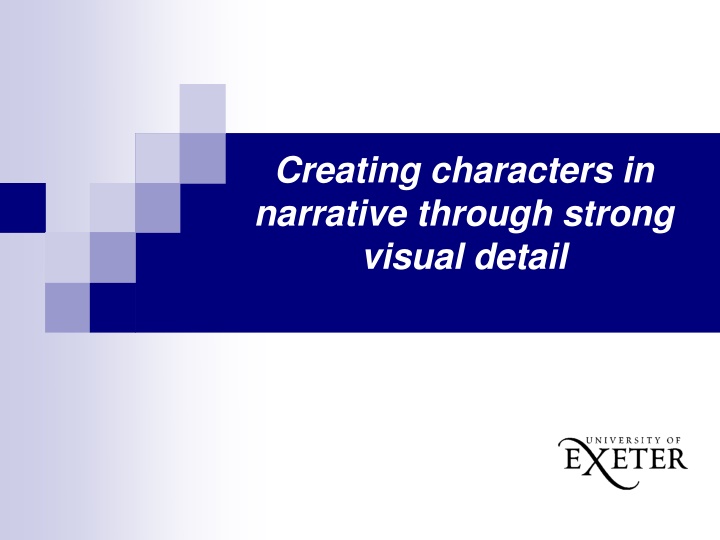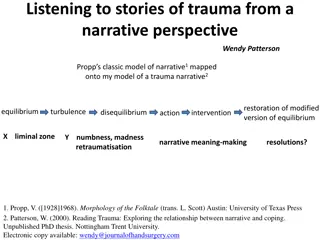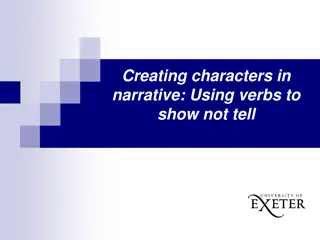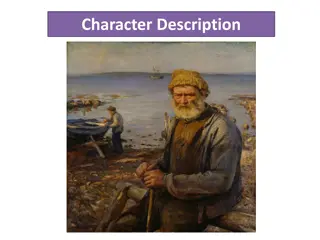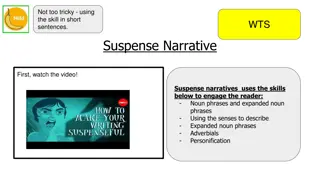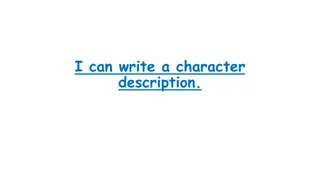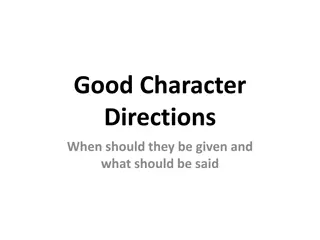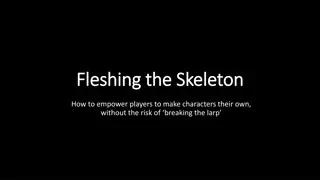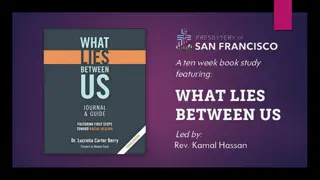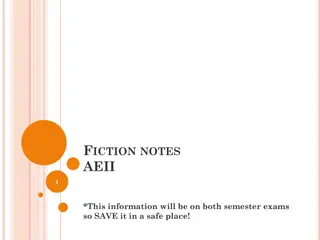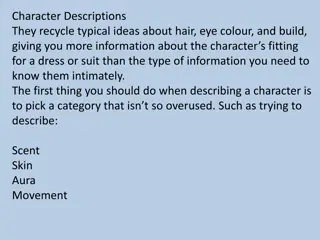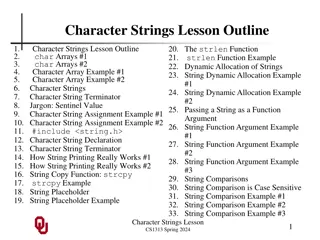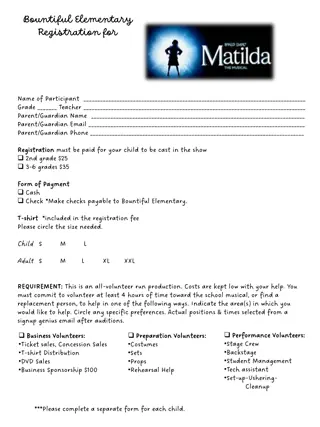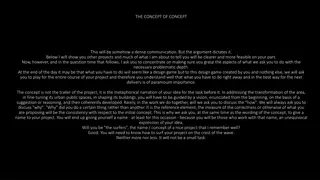Mastering Character Descriptions in Narratives
Dive into the art of creating vivid characters through strong visual detail in narrative writing. Learn how to show, not tell, by utilizing specific, concrete descriptions that bring your characters to life in the reader's mind. Explore the importance of naming, inner reflections, and dialogue to enhance character development.
Download Presentation

Please find below an Image/Link to download the presentation.
The content on the website is provided AS IS for your information and personal use only. It may not be sold, licensed, or shared on other websites without obtaining consent from the author.If you encounter any issues during the download, it is possible that the publisher has removed the file from their server.
You are allowed to download the files provided on this website for personal or commercial use, subject to the condition that they are used lawfully. All files are the property of their respective owners.
The content on the website is provided AS IS for your information and personal use only. It may not be sold, licensed, or shared on other websites without obtaining consent from the author.
E N D
Presentation Transcript
Creating characters in narrative through strong visual detail
LEAD Principles PRINCIPLE LINKS EXPLANATION RATIONALE To establish a purposeful learning reason for addressing grammar, and connect grammar with meaning and rhetorical effect Make a link between the grammar being introduced and how it works in the writing being taught To avoid writing lessons becoming mini- grammar lessons, and to allow access to the structure even if the grammar concept is not fully understood To integrate reading and writing and show how real writers make language choices EXAMPLES Explain the grammar through examples, not lengthy explanations AUTHENTIC TEXTS Use authentic texts as models to link writers to the broader community of writers To promote deep metalinguistic learning about why a particular choice works, and to develop independence rather than compliance DISCUSSION Build in high-quality discussion about grammar and its effects
Creating Characters in Narrative Show not tell: reveal your character through showing what they are like, not just telling the reader; Use specific, concrete detail to describe characters to make your readers believe in them; Create strong visual descriptions which allow your reader to see the character in their own mind s eye; Think about how you name your characters; Reveal inner reflections so your readers know what your characters are thinking and feeling; Use dialogue to reveal your character.
What do you see in your mind s eye when you read each description? Which details stand out for you? Visualising Characters Mr Wormwood was a small ratty-looking man whose front teeth stuck out underneath a thin ratty moustache. Matilda by Roald Dahl He wore round glasses held together with a lot of Scotch tape because of all the times Dudley had punched him on the nose. The only thing Harry liked about his appearance was a very thin scar on his forehead which was shaped like a bolt of lightning. Harry Potter and the Philosopher s Stone by J.K.Rowling He wore nothing but a pair of tattered breeches bunched at the waist, and there was a large knife in his belt. Kensuke s Kingdom by Michael Morpurgo
Visualising Characters: Provide Specific, Concrete Details Mr Wormwood was a small ratty-looking man whose front teeth stuck out underneath a thin ratty moustache. Matilda by Roald Dahl He wore round glasses held together with a lot of Scotch tape because of all the times Dudley had punched him on the nose. The only thing Harry liked about his appearance was a very thin scar on his forehead which was shaped like a bolt of lightning. Harry Potter and the Philosopher s Stone by J.K.Rowling Long extended noun phrases provide the concrete, specific detail.
Long extended noun phrases provide the concrete, specific detail that helps us visualise characters You can build extended noun phrases through: Premodifying a noun with determiners, adjectives and adverbs: a small ratty-looking man Mr Wormwood was a small ratty-looking man whose front teeth stuck out underneath a thin ratty moustache. a very thin scar The only thing Harry liked about his appearance was a very thin scar on his forehead which was shaped like a bolt of lightning.
Long extended noun phrases provide the concrete, specific detail that helps us visualise characters You can build extended noun phrases through: Postmodifying a noun with prepositional phrases and subordinate clauses: Mr Wormwood was a small ratty-looking man whose front teeth stuck out underneath a thin ratty moustache. The only thing Harry liked about his appearance was a very thin scar on his forehead which was shaped like a bolt of lightning.
Visualising Characters: Provide Specific, Concrete Details What do you see in your mind s eye when you read this description of Kensuke? Which details stand out for you? He was diminutive, no taller than me, and as old a man as I had ever seen. He wore nothing but a pair of tattered breeches bunched at the waist, and there was a large knife in his belt. He was thin, too. In places under his arms, round his neck and his midriff his copper brown skin lay in folds about him, almost as if he d shrunk inside it. What little hair he had on his head and his chin was long and wispy and white. Kensuke s Kingdom Michael Morpurgo. What language choices help you see this character? Would you like to meet this person?
Visualising Characters: Provide Specific, Concrete Details Examples He was diminutive, no taller than me, and as old a man as I had ever seen. He wore nothing but a pair of tattered breeches bunched at the waist, and there was a large knife in his belt. He was thin, too. In places under his arms, round his neck and his midriff his copper brown skin lay in folds about him, almost as if he d shrunk inside it. What little hair he had on his head and his chin was long and wispy and white. Kensuke s Kingdom Michael Morpurgo. Links How do the extended noun phrases help you see this character? Would you like to meet this person?
Visualising Characters: Provide Specific, Concrete Details Examples He was diminutive, no taller than me, and as old a man as I had ever seen. He wore nothing but a pair of tattered breeches bunched at the waist, and there was a large knife in his belt. He was thin, too. In places under his arms, round his neck and his midriff his copper brown skin lay in folds about him, almost as if he d shrunk inside it. What little hair he had on his head and his chin was long and wispy and white. Kensuke s Kingdom Michael Morpurgo. Links How do these free-standing adjective choices help you see this character? Would you like to meet this person?
Verbalising the Grammar-Writing Link A crucial element of the LEAD principles is helping writers to think explicitly (metalinguistically) about the choices they make. As a teacher, you need to support this by being crystal clear yourself about how you verbalise the link between a grammar choice and its effect in a particular text/context. Then express this in student-friendly language, as below. Verbalisation to share with students: When you are creating characters in narrative, you can think about how to make your readers believe in them. Strong visual descriptions can help your reader imagine the character clearly. Choose extended noun phrases and freestanding adjectives carefully!
